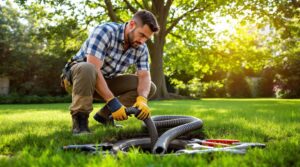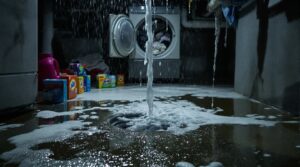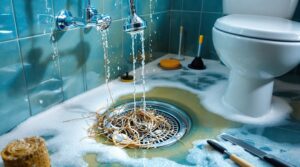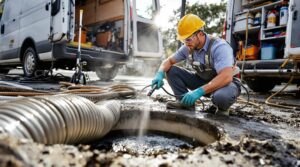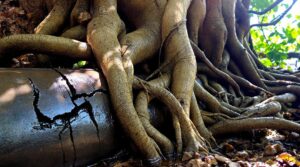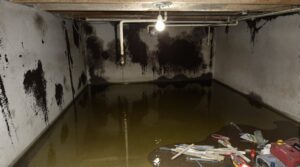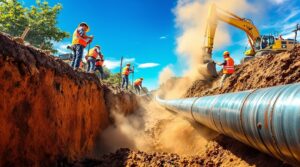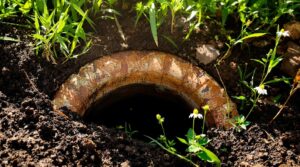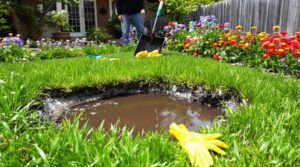Key indicators of a broken sewer pipe include slow-draining fixtures, gurgling toilets, and persistent foul odors from drains. External signs manifest as pooling sewage water, unusually lush grass patches, and ground depressions around the property. Indoor warning signs often present as multiple clogged drains, black mold growth, and sewer gas smells. Understanding these warning signs enables property owners to address potentially serious plumbing issues before extensive damage occurs.
Key Takeaways
- Foul sewer gas odors coming from drains and toilets, accompanied by gurgling sounds when flushing or using sinks.
- Multiple slow-draining fixtures throughout the house and recurring clogs that persist despite regular drain cleaning.
- Pools of sewage water in yard areas, often accompanied by unusually lush or green patches of grass.
- Foundation cracks, ground depression, or pavement damage near sewer line locations on your property.
- Presence of toxic black mold on walls and increased rodent activity around your property's exterior areas.
Understanding Sewer Pipe Systems and Their Function
A properly functioning sewer pipe system forms the backbone of modern wastewater infrastructure, comprising multiple interconnected components that work together to safely transport waste from buildings to treatment facilities.
The primary sewer system components include collection pipes, main sewer lines, lateral lines, and cleanouts, each serving specific roles in the wastewater management process. Modern collection pipes are constructed using durable materials like PVC, concrete, or clay for long-lasting performance. The system begins with lateral sewer lines connecting individual buildings to main sewer lines, which transport waste to treatment facilities.
Essential components like traps prevent sewer gases from entering buildings, while vent systems maintain proper pressure throughout the network. Pump stations assist in moving wastewater through flat terrain or elevating it to reach treatment plants.
The wastewater treatment processes involve multiple stages, including screening, settling, and biological treatment, before the treated water exits through outfall pipes into receiving water bodies. Regular maintenance through manholes, equipped with channels, inverts, and benches, guarantees the system's continued efficiency.
Common External Warning Signs of Sewer Pipe Damage
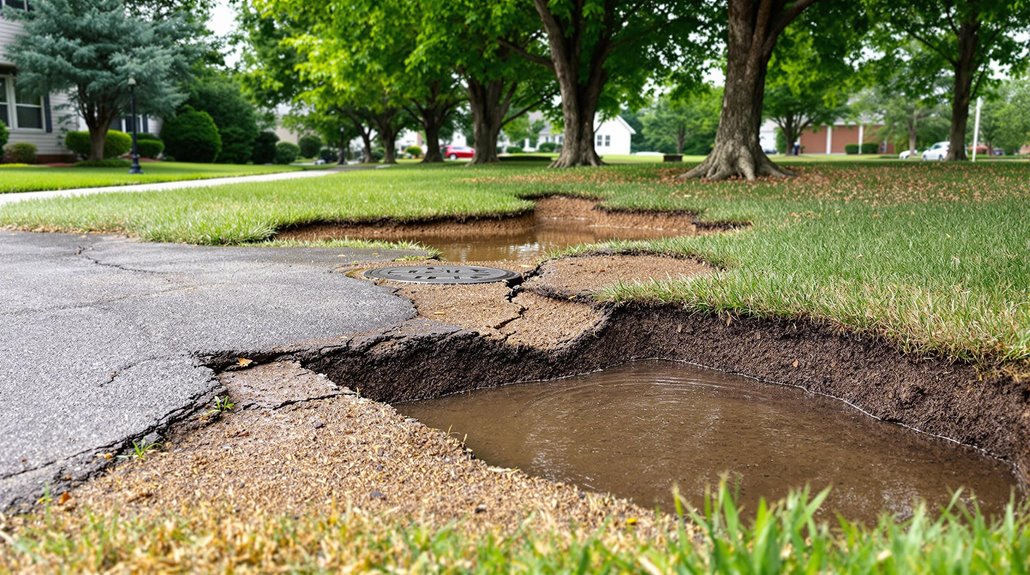
Recognizing external warning signs of sewer pipe damage enables property owners to address potential issues before they escalate into costly emergencies. Several key sewer pipe symptoms manifest through visible indicators in the surrounding environment.
In outdoor areas, prominent yard indicators include unexplained pools of sewage water, unusually lush grass patches, and persistent sewer gas odors. Mold and mildew growth along walls or floors often indicates leaking sewer lines. The presence of these signs often correlates with underground pipe failures.
Additionally, increased rodent activity and foundation cracks may signal serious structural compromises in the sewer system.
Drainage patterns provide essential diagnostic information through symptoms such as slow-draining fixtures, water emerging from sewer cleanouts, and gurgling sounds from drains.
Visual indicators like ground depression, pavement cracks, and irregular vegetation growth patterns further suggest underlying pipe damage.
Property owners should also monitor for consistent foul odors, unusual drain noises, and the presence of gas bubbles in standing water, as these symptoms typically indicate significant sewer line deterioration.
Indoor Indicators That Signal Sewer Line Problems
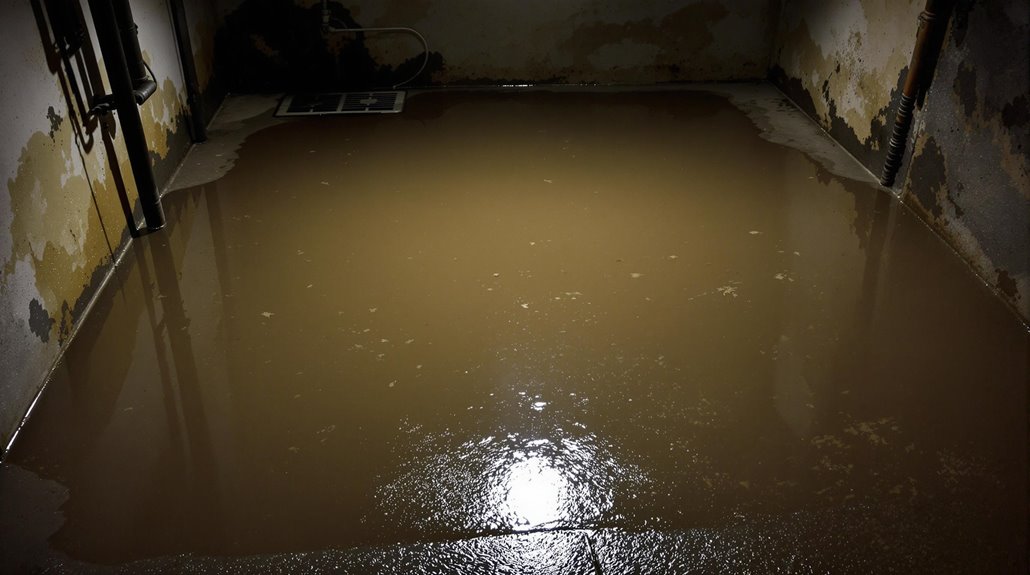
The manifestation of sewer line problems within residential structures often presents through distinct and recognizable indoor warning signs.
Primary indicators include slow-moving drains across multiple fixtures, with water taking longer than usual to evacuate from sinks, bathtubs, and appliances. Persistent clogs affecting various plumbing points simultaneously suggest a systemic issue rather than isolated blockages.
Toilet gurgling and unusual sounds emanating from drains, particularly when other fixtures are in use, indicate potential sewer line complications. The presence of toxic black mold on walls near plumbing fixtures can signal hidden pipe damage.
These acoustic symptoms often accompany foul odors permeating from drains and basement areas, signifying trapped sewer gases. The interconnected nature of these problems becomes evident when using one fixture affects others – for instance, running washing machines may cause toilet overflows or sink backups.
Water pressure fluctuations affecting toilet water levels and recurring drainage issues across multiple fixtures further substantiate the presence of serious sewer line deterioration.
Health and Safety Risks of Broken Sewer Pipes
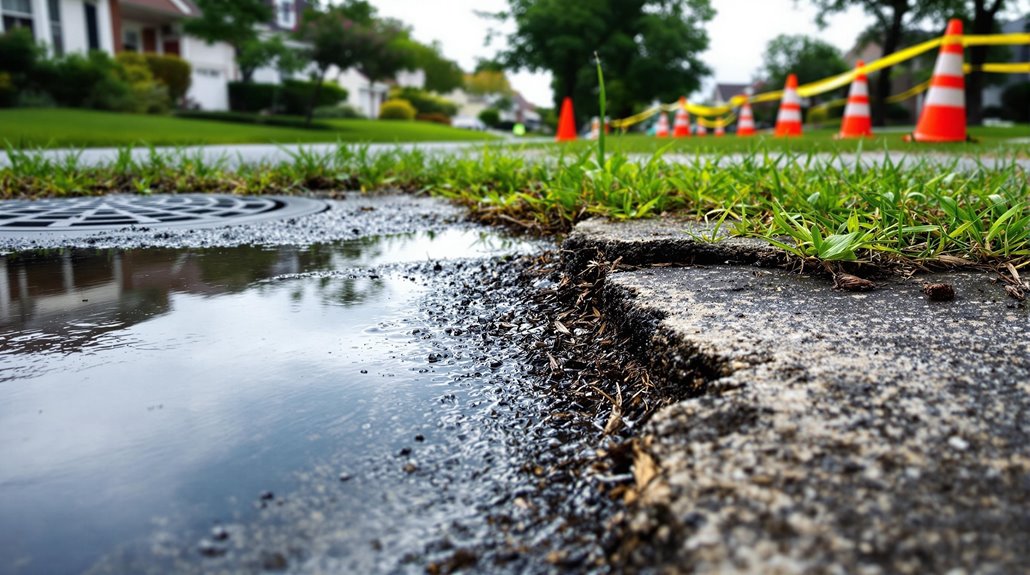
Broken sewer pipes pose significant health hazards that extend beyond structural concerns, introducing dangerous pathogens and toxins into living environments. Sewage exposure can trigger various gastrointestinal infections, including E. coli and salmonella. Contaminated water may transmit serious diseases like hepatitis A, typhoid fever, and cholera.
The health risks escalate when sewer line damage creates conditions favorable for mold growth and pest infestations. Chronic exposure to sewer gases, particularly methane, can result in respiratory problems, headaches, and potential gas poisoning.
The contamination of soil and groundwater introduces additional dangers, as harmful bacteria and viruses can persist in the environment, leading to long-term exposure risks through direct contact or inhalation of airborne particles.
Professional intervention becomes vital in these situations, as proper repair and sanitization are essential to eliminate these health threats and restore a safe living environment.
Professional Inspection and Diagnostic Methods
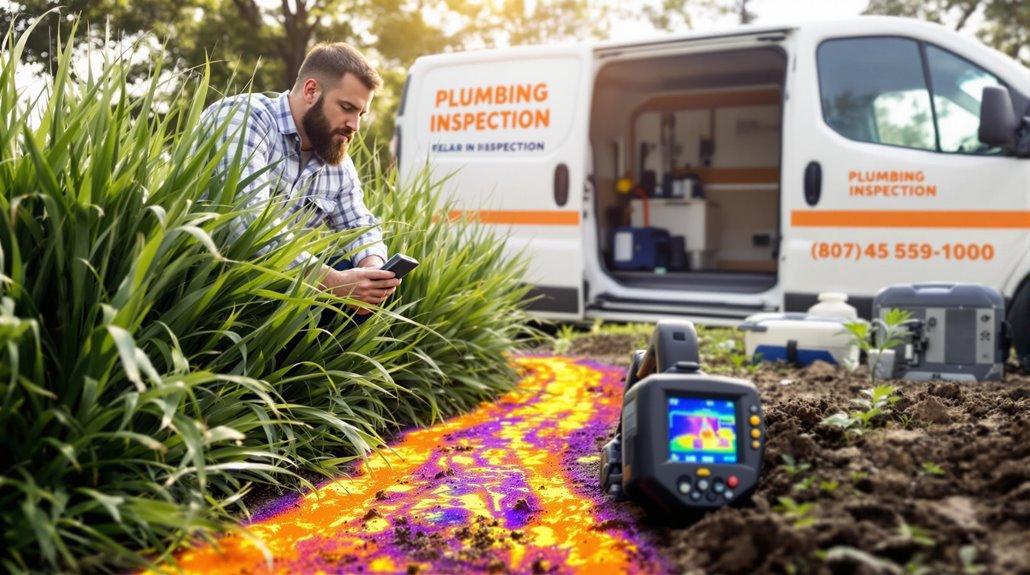
Modern sewer pipe inspection relies on sophisticated diagnostic methods that combine advanced imaging technology with precision measurement tools. CCTV technology serves as a primary inspection method, utilizing remote-controlled rovers equipped with high-resolution cameras to identify structural defects, root intrusions, and blockages in pipes ranging from 4 to 48 inches in diameter.
Laser profiling provides detailed geometric analysis of pipe conditions, measuring interior dimensions to detect deformities and structural issues. This method generates precise data for liner design and quality control.
Additional diagnostic techniques include sonar inspection for partially filled pipes, which uses sound waves to detect submerged defects and sediment accumulation. Specialized testing methods such as hydrostatic pressure tests, smoke testing, and acoustic inspections complement these primary approaches by identifying specific types of pipe damage and leaks.
These extensive inspection methods enable accurate assessment of sewer pipe conditions and inform appropriate repair strategies.
Essential Steps for Immediate Response
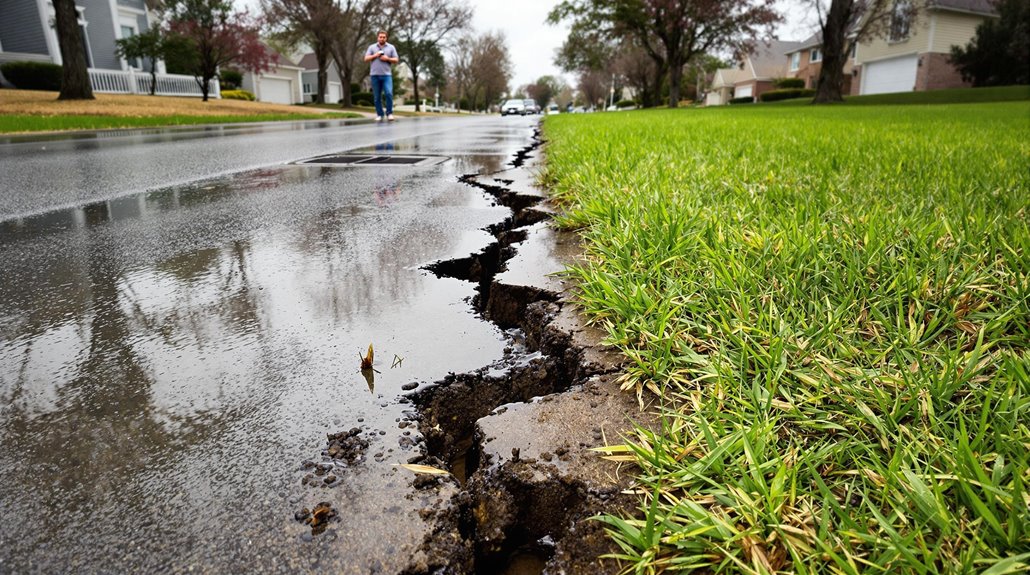
Responding effectively to a broken sewer pipe requires immediate identification and containment of the problem through systematic steps. Upon detecting signs of sewer line damage, essential response measures begin with shutting off the main water supply to prevent further complications.
Professional assistance should be contacted immediately while affected areas are isolated to minimize exposure to potential health hazards.
Immediate damage control involves documenting the extent of the problem through photographs and videos for insurance purposes, while simultaneously preventing the use of all plumbing fixtures. Residents must be informed of the situation and necessary precautions.
If sewage has entered the living space, proper protective equipment must be utilized during initial cleanup efforts. The implementation of these measures should occur while awaiting professional assessment, which typically includes camera inspection to precisely locate the point of failure and determine the most appropriate repair method.
Long-Term Consequences of Unaddressed Sewer Issues
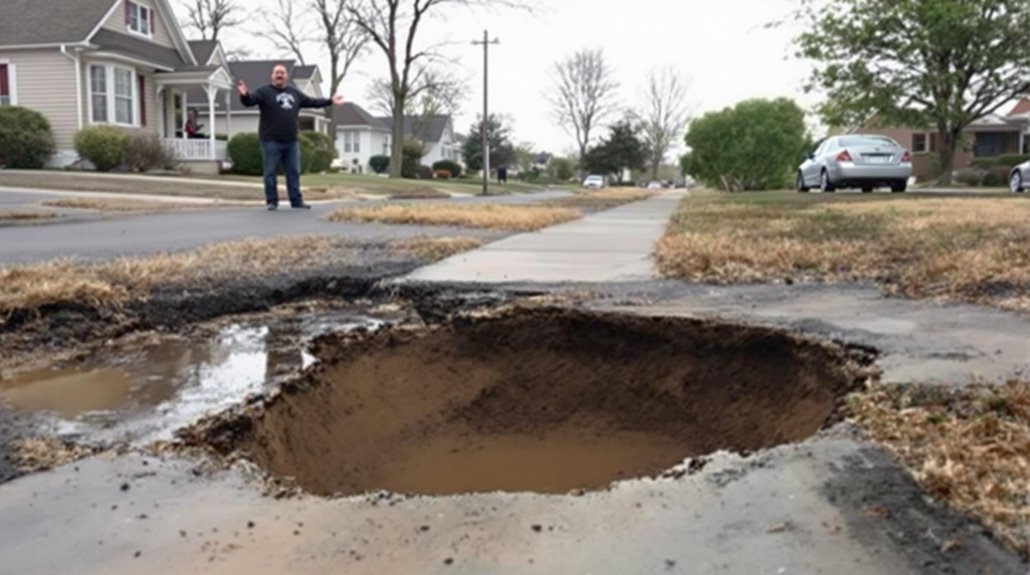
When sewer line issues remain unaddressed, property owners face a cascade of severe consequences that extend far beyond initial plumbing concerns.
Structural integrity becomes compromised as foundation weakness develops, while persistent moisture leads to wall and ceiling deterioration. These conditions create significant safety hazards and potential structural collapse risks.
The financial risks escalate dramatically over time. Property owners encounter mounting repair costs, decreased property values, and potential liability claims.
Business operators may face revenue losses due to mandatory closures during repairs, while homeowners risk regulatory penalties for non-compliance with maintenance requirements.
Environmental impacts manifest through soil and groundwater contamination, affecting both immediate surroundings and broader ecosystems.
Health hazards proliferate as sewage leaks introduce harmful pathogens, leading to disease transmission risks and respiratory issues from mold growth.
Additionally, water supply contamination and insect infestations create long-lasting public health concerns that require extensive remediation efforts.
Prevention Strategies and Regular Maintenance Tips

Regular sewer line inspections performed by qualified professionals can identify potential issues before they develop into major problems.
Smart drain cleaning habits, including proper disposal of waste and the use of drain strainers, greatly reduce the risk of blockages and pipe damage.
These preventive measures, combined with scheduled maintenance, form an extensive approach to protecting the integrity of residential sewer systems.
Routine Sewer Line Inspections
A thorough sewer line inspection program forms the foundation of effective plumbing system maintenance. Regular inspections utilizing advanced inspection technologies, such as CCTV systems and lamping techniques, enable early detection of potential issues before they escalate into major problems.
Routine maintenance protocols typically include scheduled CCTV inspections for extensive system evaluation, visual assessments of pipes and surrounding areas, and targeted cleaning of sewer lines to prevent blockages.
These systematic inspections serve multiple critical functions: they help identify structural defects, detect root intrusions, and reveal areas of potential failure. Professional inspections also guarantee compliance with maintenance regulations while simultaneously extending system longevity and reducing long-term repair costs.
When implemented consistently, these inspection practices greatly minimize the risk of sewage backups and associated health hazards.
Smart Drain Cleaning Habits
Maintaining proper drain cleaning habits serves as the cornerstone of effective sewer line maintenance and longevity.
Regular drain maintenance includes weekly hot water flushing and the strategic use of baking soda and vinegar solutions to dissolve residues and prevent blockages. Installing drain covers and cleaning strainers consistently helps prevent debris accumulation in pipes.
Effective cleaning techniques incorporate both biological and chemical approaches. Enzyme-based cleaners can be applied monthly to break down organic buildups, while harsh chemicals should be limited to bi-annual usage to protect pipe integrity.
Additionally, implementing preventative measures such as proper disposal of grease and oils, regular system checks, and careful monitoring of food waste disposal considerably reduces the risk of pipe damage and expensive repairs.
The combination of these practices guarantees peak sewer line performance.
When to Call a Professional Plumber
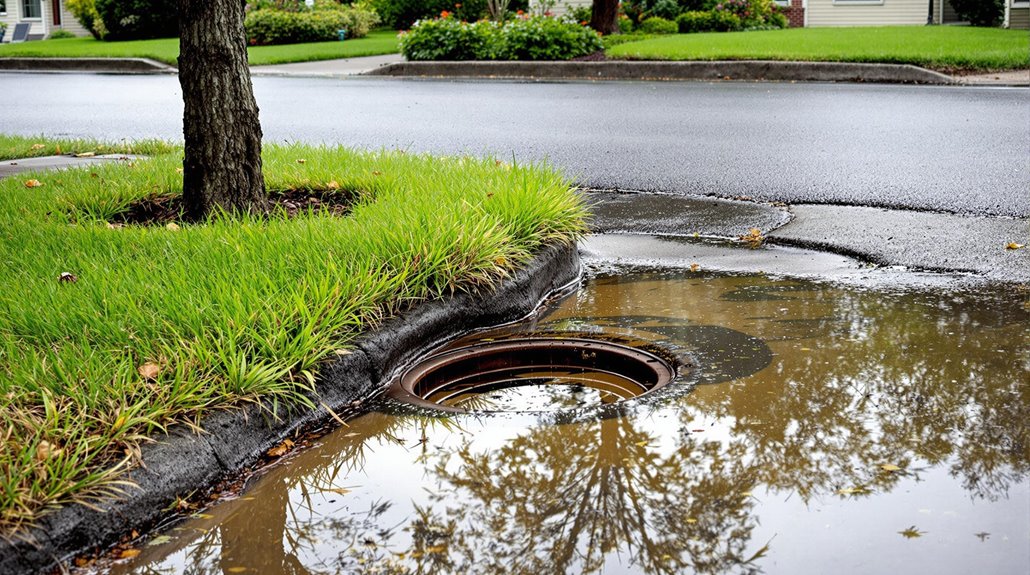
Professional plumbers should be contacted immediately when homeowners observe specific indicators of sewer line problems, as these issues can rapidly escalate into costly property damage. Multiple signs of leakage, such as gurgling drains, foul odors, or backed-up sewage, indicate severe system compromise that requires expert intervention.
| Warning Sign | Causes of Damage | Action Required |
|---|---|---|
| Backed-up Sewage | Tree Root Invasion | Immediate Professional Inspection |
| Multiple Slow Drains | Pipe Corrosion | Camera Diagnosis |
| Foundation Issues | Ground Settling | Structural Assessment |
A professional plumber can perform thorough diagnostic tests using specialized equipment like camera systems to identify the exact location and extent of damage. Early detection through regular maintenance can prevent extensive repairs, while ignoring warning signs often leads to system failure. When mushy ground, unusually green patches, or persistent sewage odors appear, professional assessment becomes critical to prevent health hazards and structural damage to the property.
The Benefits Of Consulting A Public Adjuster
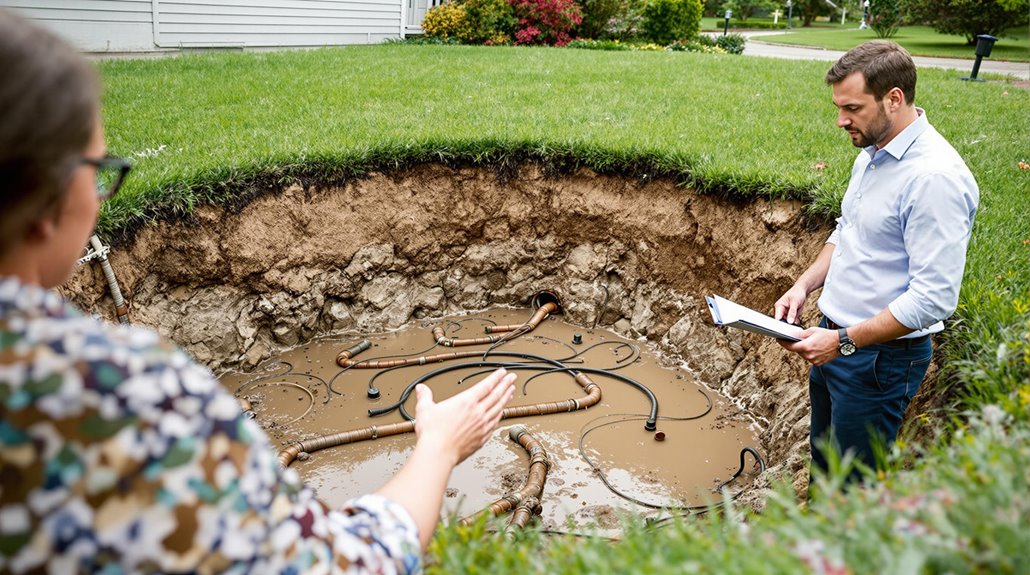
When faced with significant sewer pipe damage, consulting a public adjuster can provide expertise in managing complex insurance claims while ensuring objective assessment of all property damages.
Public adjusters streamline the claims process by handling documentation, communication, and negotiations with insurance companies on behalf of the property owner.
Statistical evidence indicates that claims handled by public adjusters often result in substantially higher settlements, sometimes reaching three to five times more than claims filed without professional representation.
Their compensation structure aligns with achieving successful outcomes since fees are typically only collected upon favorable settlement results.
Expertise In Insurance Claims
Insurance claims for broken sewer pipes can be complex and challenging to navigate without professional assistance. Public adjusters provide specialized expertise in managing these claims, ensuring thorough documentation and effective insurance negotiations. Their knowledge of policy coverage and industry regulations helps identify all potential damages while maximizing settlement outcomes.
These professionals serve as objective representatives who advocate solely for the property owner's interests. Working on a contingency basis, they meticulously assess damage, prepare required documentation, and communicate with insurance carriers.
Their expertise extends to understanding complex policy language and identifying coverage parameters that property owners might otherwise overlook. By leveraging their experience in claims processing, public adjusters help streamline the settlement process while pursuing the most favorable financial resolution for their clients.
With contingency fee rates typically ranging from 5-20% of the final settlement, public adjusters often provide a more cost-effective solution compared to legal representation.
Objective Damage Assessment
Public adjusters bring essential expertise to the damage assessment process through their unbiased evaluation of sewer pipe failures and related property damage.
Using advanced assessment techniques like moisture meters and thermal imaging, they systematically document damage indicators and potential structural issues that may not be visible to the untrained eye.
- They capture extensive photographic and video evidence of affected areas, creating detailed documentation of water damage patterns and severity.
- They employ specialized moisture detection equipment to identify hidden water infiltration within walls and foundations.
- They utilize thermal imaging technology to map the extent of water migration and potential structural compromise.
Their thorough documentation process includes detailed inventories of damaged items, professional repair estimates, and evidence of additional living expenses, ensuring a complete and accurate claim submission that reflects the true scope of the damage.
Unlike insurance adjusters who may focus on minimizing settlement costs, public adjusters work to ensure homeowners receive maximum compensation for sewer-related damages.
Streamlined Claim Process
Maneuvering the complexities of a sewer pipe damage claim requires strategic expertise and methodical coordination. Public adjusters streamline this process by implementing extensive claim management protocols that guarantee thorough documentation and timely submissions.
These professionals handle all aspects of the claim, from initial damage documentation to final settlement negotiations. They conduct detailed property inspections, coordinate with necessary parties, and maintain precise records of all communications with insurance providers.
Their expertise in policy interpretation helps prevent claim denials and underpayments while maximizing settlement potential.
Through their systematic approach, public adjusters greatly reduce the burden on property owners, allowing them to focus on recovery while ensuring their interests are protected throughout the claims process. This professional oversight helps secure fair and expedited claim resolutions.
With settlement fees typically ranging from 5% to 15%, public adjusters provide cost-effective representation that often results in significantly higher compensation for property owners.
Higher Claim Payouts & Settlements
When evaluating financial outcomes of sewer pipe damage claims, statistical evidence consistently demonstrates that engaging a public adjuster leads to markedly higher settlement amounts.
Through expert policy interpretation and strategic claim negotiation, these professionals leverage their specialized knowledge to maximize compensation for property owners.
- Public adjusters conduct thorough damage assessments, documenting both visible and concealed sewer pipe deterioration.
- They meticulously analyze insurance policies to identify all applicable coverage provisions and endorsements.
- Their expertise enables accurate valuation of structural damage, remediation costs, and associated losses.
Working on a contingency basis, public adjusters are inherently motivated to secure the best settlements.
Their professional representation guarantees that complex technical aspects of sewer system damage are properly documented and substantiated, leading to more favorable claim outcomes for property owners.
About The Public Claims Adjusters Network (PCAN)
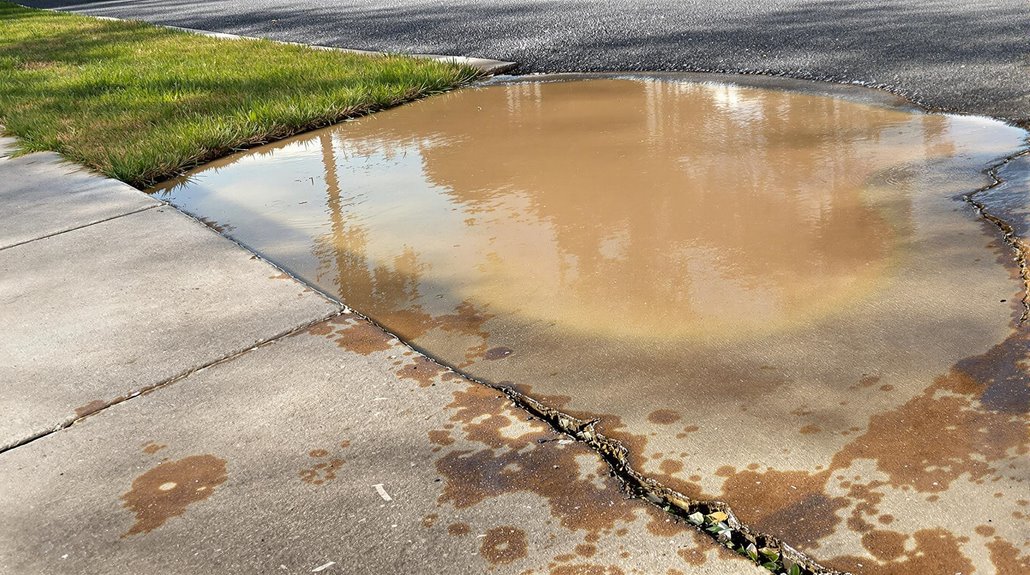
An established industry leader, the Public Claims Adjusters Network (PCAN) delivers extensive insurance claim management services through its nationwide network of licensed adjusters. Operating independently from insurance companies, PCAN provides all-encompassing solutions with proven expertise spanning decades. The organization's client-centric approach guarantees ideal outcomes through customized services and expert negotiations.
| Service Type | Description | Client Benefit |
|---|---|---|
| Claims Management | Full-service handling | 300-400% higher settlements |
| Response Time | On-site within hours | Immediate damage mitigation |
| Payment Structure | Contingency-based fees | No upfront costs |
PCAN utilizes industry-leading software and employs certified public adjusters who conduct thorough damage assessments. Their services include temporary housing arrangements, disaster recovery planning, and detailed CPA earning analyses. Operating 24/7, PCAN offers free consultations for both residential and commercial claims, supported by dedicated call centers providing continuous status updates throughout the claims process. All member adjusters must maintain strict ethical standards through bi-yearly audits to ensure the highest level of professional service.
Frequently Asked Questions
Can Tree Roots Damage Sewer Pipes Even if They're Not Directly Above?
Tree root intrusion can damage sewer pipes regardless of tree location, as roots can extend laterally significant distances underground seeking moisture and nutrients. Regular sewer pipe maintenance helps detect potential threats early.
How Long Does a Typical Sewer Pipe Repair or Replacement Take?
Sewer repair timeline typically ranges from 1-3 days for standard replacements. Complex projects involving deeper excavation or longer pipe runs may extend the replacement process to 4-5 days.
Does Homeowner's Insurance Cover Damage From Broken Sewer Pipes?
While basic home insurance typically excludes sewer line damage, specialized endorsements can provide coverage, subject to policy limits. Sudden, accidental damage may qualify; gradual deterioration remains excluded.
What's the Average Lifespan of Residential Sewer Pipes?
Residential sewer pipe lifecycle expectations vary by material: PVC and cement pipes last 100 years, cast iron 75 years, and clay 30-60 years. Regular pipe maintenance greatly influences these lifespans.
Can I Repair Small Sewer Pipe Cracks With DIY Methods?
Like mending a wounded vessel, small sewer pipe cracks can be effectively addressed through DIY repairs using specialized pipe sealing materials including epoxy resins, fiberglass tape, and repair couplings.
References
- https://www.cartersmyplumber.com/broken-sewer-pipe/
- https://www.mallickplumbing.com/2024/09/24/ask-the-expert-signs-of-a-broken-sewer-pipe-19/
- https://www.nicksplumbing.com/what-are-the-signs-of-a-broken-sewer-pipe/
- https://patrickrileyservices.com/help-guides/signs-symptoms-broken-sewer-line
- https://sekisui-spr.com/blog/2021/05/24/signs-of-collapsed-sewer-line/
- https://thepipemedic.com/parts-of-a-sewer-system/
- https://mainstreamhomeservices.com/blog/signs-of-a-broken-sewer-pipe-you-should-never-ignore/
- https://wootenknockoutplumbing.com/discover-sewer-line-anatomy/
- https://itsdone.com/blog/12-signs-of-a-damaged-or-broken-sewer-pipe/
- https://blog.wincan.com/sewer-basics-parts-of-a-manhole-glossary
